This article was published in Scientific American’s former blog network and reflects the views of the author, not necessarily those of Scientific American
Over the weekend of the 24th and 25th June 2017, the 2017 Amphibian Conservation Research Symposium (ACRS) was held at the University of Kent, Canterbury, UK. I attended and had a great time: the symposium was an excellent mix of cutting-edge research, reports from the field and outstanding keynote presentations. The University of Kent is home to DICE – the Durrell Institute of Conservation and Ecology – and thus to a group of researchers actively involved in global and local conservation research.
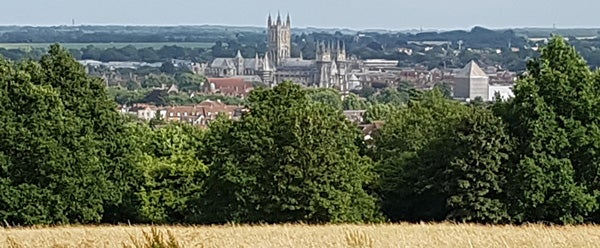
Canterbury: not a bad place for a conference. The view from the University of Kent. Credit: Darren Naish
A great many of the people who spoke at the event are prominent advocates of amphibian conservation online (many are on twitter). Indeed, the number of really good talks was extraordinary and I’ve tried hard while writing this not to talk too much about each one... I came away with eight pages of notes and have mostly failed in that endeavour. The talks were dominated by work on frogs (meaning anurans in general); there were a few on salamanders (mostly Fire salamanders Salamandra salamandra and European newts) but nothing on caecilians. This is what you’d expect given the proportions of those various groups, anurans being by far the biggest. We even watched a movie (Madagascar: Life on the Edge).
On supporting science journalism
If you're enjoying this article, consider supporting our award-winning journalism by subscribing. By purchasing a subscription you are helping to ensure the future of impactful stories about the discoveries and ideas shaping our world today.

I know what every conference venue needs: a giant version of Dürer's hare made of sheets of cardboard. Credit: Darren Naish
I have to mention the giant cardboard hare that was right outside the venue for the duration. It’s evidently a scaled-up version of the young hare painted by Albrecht Dürer’s in 1502, and a fine work it was. Part of one of its ears had fallen off at some point, hence the effort to stop people from approaching too closely. Anyway…
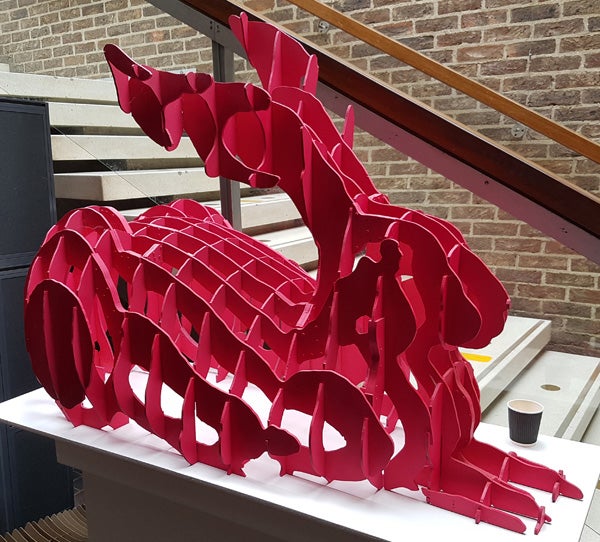
The prototype of the giant Dürer's hare shown above; coffee cup for scale. I'd like to know who the artist was. Credit: Darren Naish
Amphibian Ark and ex-situ conservation. Saturday kicked off with Anne Baker’s keynote on the Amphibian Ark project and its short-term and long-term goals, the aim being to focus on species that can’t be safe-guarded in their own environments. While the aim of the AArk is to maintain populations in captivity, the plan has never been to end up with “frogs in boxes” (see Marris 2008), and work with in-situ specialist groups and partners is essential. Gerardo Garcia then discussed some fascinating research which shows that captive mantellas respond strongly to the recorded calls of wild individuals: for reasons that are not yet clear, the calls of captive animals are apparently “flat and boring”. Captivity changes animals; a fascinating subject.
Brian Gratwicke covered research on Panamanian frogs and effects to determine why some are better at resisting Bd than others. Could we select those individuals better at surviving Bd and breed from them? The problem there is that it’s simply difficult to know what to select for, since the individuals that express anti-Bd properties express extra versions of everything (as goes skin secretions and chemicals and so on).
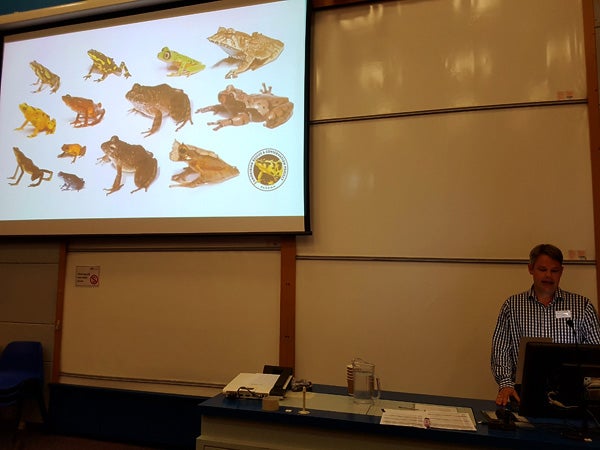
Brian Gratwicke discusses frog conservation in Panama; the excellent photos are his. Credit: Darren Naish
Alannah Beiga looked at how we can work to maximise breeding success in ex-situ conservation; results vary widely across amphibian species, species-specific knowledge is essentially for things to work, and data on those attempts that fail is often deficient (another reminder of why negative results should be published). Kåre Fog reviewed work involving small populations in Denmark and efforts to save them, sometimes via the introduction of fresh genes. This work – which involves conservation management and the monitoring of evolutionary trends – has apparently proved hard to publish.
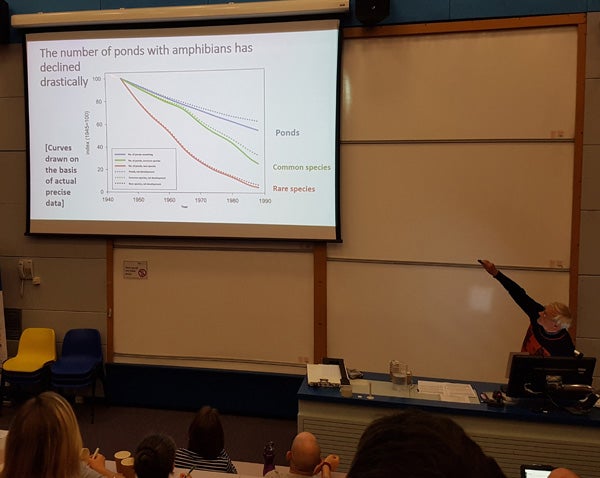
Kåre Fog discussing amphibian and pond declines in Denmark; the situation is not all that great. Credit: Darren Naish
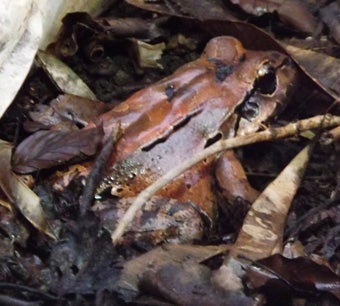
Captive Mountain chicken at Chester Zoo. Credit: Darren Naish
Frogs of the Americas, Europe and Asia. Natalie Calatayud spoke about work on the Southern mountain yellow-legged frog Rana muscosa, her research showing that brumation was important in breeding success. Stephanie Layson reviewed the nutritional requirements of the Mountain chicken or Giant ditch frog Leptodactylus fallax, a famously big frog from Dominica and Montserrat, fondly remembered by local people as a food source but now critically endangered. Particularly interesting was the discussion of a 1982 study that involved the euthanizing of numerous wild specimens in order to study stomach contents: today, the idea that researchers might kill some number of these animals for research is quite remarkable. And Amaël Borzée discussed the use of rice paddies as breeding grounds by South Korean Dryophytes hylids. The frogs’ breeding timetable is linked to rice growth since they use tall stems to call from but also have their spawn and/or tadpoles destroyed if they breed too early (everything gets crushed by tractors).
Rob Ward spoke about Agile frogs Rana dalmatina on Jersey, a population that – by 1986 – was down to just two groups and in need of help. Efforts to deepen ponds, provide legal protection and protect spawn from damage have been successful but research is ongoing since several questions remain about the ecology and behaviour of these frogs. Water extraction and drought are problems affecting the animals and their habitats.
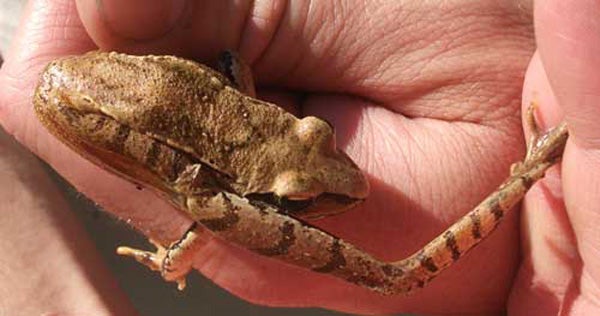
Agile frogs are especially long-legged, the heel extending well beyond the snout when the leg is straightened (don't worry; this doesn't hurt or damage the frog). They're also often sharp-snouted and with an especially big tympanum. This individual is not from Jersey but Romania. Credit: Darren Naish
More frogs: of Australia and South America. Our second keynote was provided by Jean-Marc Hero and covered amphibian conservation from an Australian perspective. Australia is one of the places where it first became obvious that there was a problem, the loss of species like the gastric-brooding Rheobatrachus species during the 1980s being among the early warning signs. Part of Jean-Marc’s research has concerned thermal physiology and stress hormones: anurans at higher altitudes have higher stress hormones, and this might make them especially susceptible to Bd.
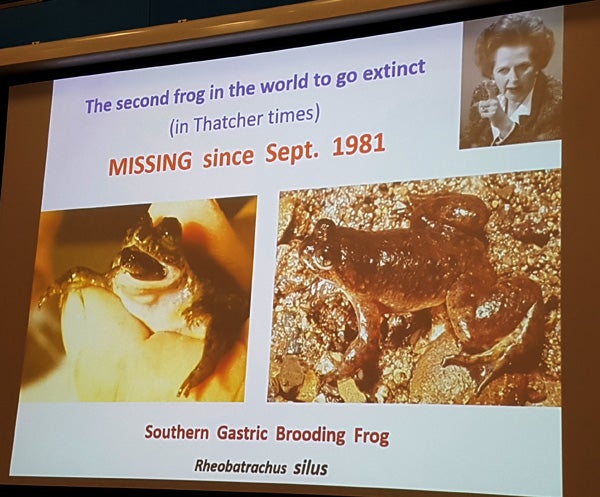
Jean-Marc Hero's slide on the loss of Rheobatrachus silus, one of the most amazing - and, potentially, important - frogs ever discovered... a frog that could turn off the digestive function of its stomach for reproductive reasons. Credit: Darren Naish
Renoir Auguste spoke about the anurans of the Aripo Savannah Scientific Research (ASSR) in Trinidad where species occur in both savannah and marsh-forest habitat. Marsh-forest diversity is highest, hylids accounting for the majority of species. Jeff Dawson discussed anurans on Hispaniola where the habitat degradation is posing a problem. Peltophryne and Rhinella toads and species of Eleutherodactylus, Osteopilus and Lithobates are among the frogs here.
Luis Marin da Fonte gave an inspirational presentation on the conservation of the Admirable red-bellied toad Melanophryniscus admirabilis, a critically endangered microendemic Brazilian toad, new to science as of 2006 and known from a single population. In 2010, it was announced that a hydroelectric project would begin 500 m upstream from the species’ type locality. Resistance from combined parties was successful in getting the project stopped, news that led to a burst of applause at the meeting. Efforts to find the species elsewhere have not been successful. How can efforts like this succeed? By involving collaboration across institutions and groups including academics, government groups, NGOs and the public.
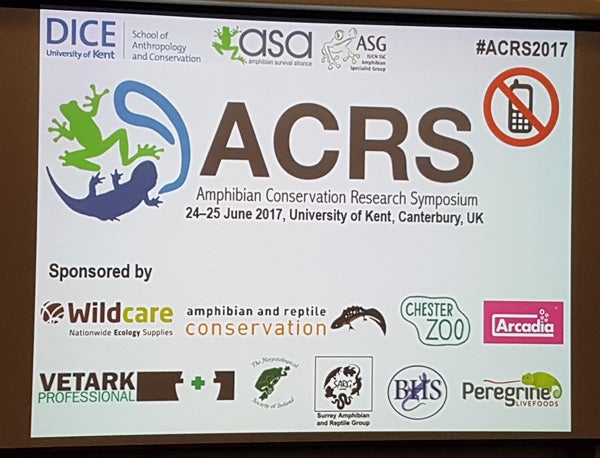
The conference holding slide... Credit: Darren Naish
Christopher Michaels looked at the successes and failures of the Global Amphibian Assessment initiative. It’s well known that we’re in a golden age of amphibian discovery, with around 150 new species being named every year (a figure that’s been consistent since about 2004). For those who scoff at this because they claim it’s the consequence of new-fangled phylogenetic species concepts and hyper-splitting: nope, it’s mostly the result of increased collecting effort in under-sampled parts of the world (see Hanken 1999). Anyway… it seems that efforts to evaluate these species as goes conservation status has not been keeping up, c 45% of the species named since 2004 lacking proper evaluation. Chris explained how researchers should be incentivised to produce such evaluations – after all, the researchers concerned are typically the ones with the specific field data and experience relevant to this issue.
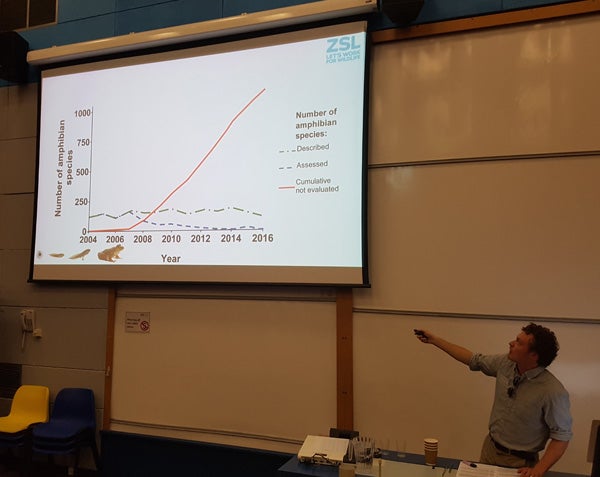
Chris Michaels shows how the conservation assessment of amphibian species has not kept pace with the rate of discovery: that massively rising red line gives some indication of how the discovery rate of amphibians has increased at an incredible rate since c 2004. Credit: Darren Naish
eDNA, the EU, pregnancy kits, and do frogs eat cardamom? Lynsey Harper provided an outstanding review of where we’re at as goes eDNA research (eDNA = environmental DNA, the new frontier in detecting organisms in the wild; a tool that allows the detection of a “wealth of biodiversity that can’t be gained by conventional means”). Her work has involved the collecting of eDNA data from over 530 ponds in the UK, the results revealing the presence of a huge variety of vertebrate species. But… does it record the presence of all the species in an area, and how do we deal with contamination? eDNA also does not provide data on biomass or abundance, merely ‘presence’. I look forward to the Harper et al. paper that includes all that UK pond data. Oh – eDNA and amphibian conservation go hand in hand due to the importance of eDNA in documenting the presence of the Great crested newt Triturus cristatus, the “model organism for eDNA”. Indeed, the very first time I ever heard of eDNA was within the context of Great crested newt research.
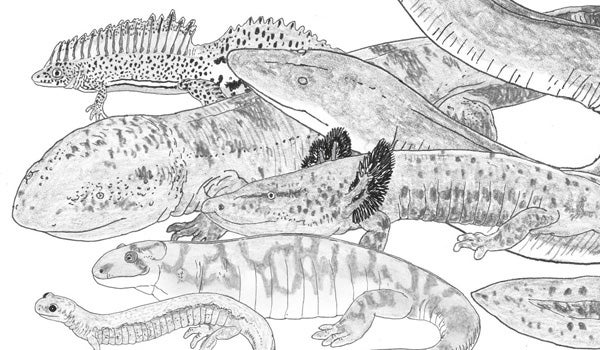
Salamanders: a montage representing several of the major living groups. Illustrations from the in-prep giant textbook (oh which GO HERE.. yes, there is a link here even though you can't see it, dammit). Credit: Darren Naish
Nicolá Lutzmann discussed EU policy as it pertains to amphibian conservation, Michael Dillon presented work on the use of a lateral-flow piece of kit (based on human pregnancy testing equipment) that checks for the presence of Bd, and Sethu Parvathy told us about the prevalent belief across the Western Ghats that frogs are bad for plantations since they eat cardamom. Yes, it seems that the association between cardamom pods and frogs has led people to think that frogs are actually guilty of cardamom consumption and hence that frogs should be killed. About 40% of people asked claimed to have seen evidence for this, the evidence seemingly being association between frogs and cardamom. An outreach campaign that aims to spread awareness of the benefits of frogs to plantations and negate the cardamom myth is underway. If you’re wondering.. stomach content data proves that the frogs do not really eat cardamom (Kanagavel et al. 2017).
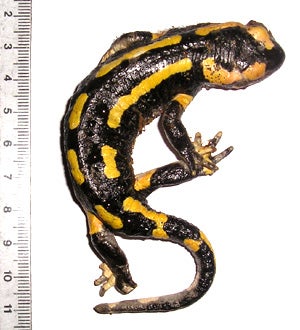
Fire salamander: a key species in An Martel's research. This is an unfortunate road casualty from France. Credit: Darren Naish
Bsal and Bd: challenges and solution. And so on to Sunday. The day started with a session heavy on chytrid and related issues. An Martel gave the day’s first keynote, devoted to Batrachochytrium salamandrivorans – Bsal – and its spread, the reservoir species that act as its host, and how different species respond to it. Bsal appears to be endemic to Asia (Martel et al. 2014): it has been identified on a museum specimen collected in 1861, can be present on Asian newts (Cynops and Paramesotriton) for six months without them dying, and Asian salamander die-offs have not been reported. One interesting aside is that Bsal can be spread on the feet of waterfowl – yikes!
Also on salamanders, Tariq Stark discussed dermocystid infections on newts in the Netherlands. Infected animals have unsightly dorsal lesions on the body and tail, larvae and neotenous individuals being affected too. Gonçalo Rosa looked at the response to Bd in Colostethus and Atelopus in Panama, in particular in the Common rocket frog A. panamansis. In a world of bad news about tropical frogs, it’s great to hear something amazingly good: this species has reappeared in an area where it had previously vanished, and it appears that it might have evolved a resistance to Bd. Alternatively, Bd in its region might have become less virulent.
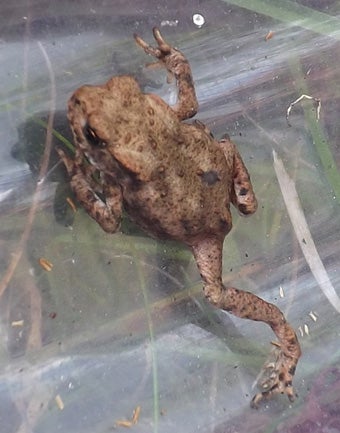
The Common toad - this is a baby one I found at a Big Pit National Coal Museum in Wales - is still abundant across the UK, but it's not as abundant as it used to be. Credit: Darren Naish
Donal Smith looked at Common toads Bufo bufo on Scottish islands to see how ‘naïve populations’ fare as goes Bd susceptibility. It might be predicted that populations with a low genetic diversity are most highly susceptible to Bd but at least one study found the opposite. Also relevant is that the size of B. bufo should make it relatively Bd-tolerant, but that the selection pressures associated with climate change are making species like the Common toad become smaller over time. Gina Della Togna discussed Atelopus sperm samples and the genetic management of captive populations and the first successful captive reproduction of Strabomantis bufoniformis, a direct-developing craugastorid sometimes called the Rusty robber frog.
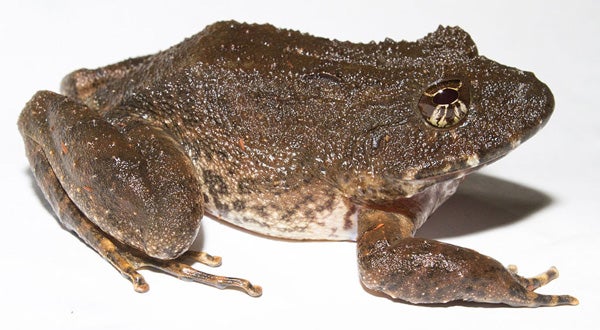
Strabomantis bufoniformis itself, a small craugastorid (c 5-9 cm SVL) of Colombia and Costa Rica. Credit: Brian Gratwicke Wikimedia(CC BY-2.0)
The impact of amphibian conservation. A Sunday afternoon keynote was given by Phil Bishop who discussed the initiation of the amphibian conservation movement in the 1980s (things really got started at the World Congress of Herpetology in 1989) and the various bodies involved in conservation and conservation research – the ASG (Amphibian Specialist Group), IUCN, ASA (Amphibian Survival Alliance) and so on – and the relationships between them. Phil told us all about Archey, a new symbol of amphibian conservation: a cuddly Archey’s frog Leiopelma archeyi who has so far met William Shatner, Lucy Lawless, Jane Goodall, Prince Charles and a long list of other celebs and personalities...
One of my favourite talks was Biraj Shretha’s on stream-dwelling frogs in Nepal, known collectively as ‘paha’. These frogs are hunted and eaten by local people – apparently pretty indiscriminately – both for protein but also because of superstitions about virility and the warding off of illness. Biraj has led a concerted effort to stop indiscriminate killing. We all know that the capture and consumption of wild animals is – for all kinds of reasons – important to people around the world; the challenge is to teach people about management and sustainability.

One of Arturo Muñoz Saravia's excellent Lake Titicaca frog photos. Credit: Darren Naish
Several of the talks discussed amazing frogs from the southern continents. Especially memorable was Arturo Muñoz Saravia’s presentation on the amazing Lake Titicaca frog Telmatobius culeus, famous for its thick, baggy skin (it’s sometimes called the Scrotum frog, I have no idea why) and aquatic lifestyle. Arturo dives in the lake to photograph these frogs in their environment and his talk featured various of his amazing photos. Much new data on the behaviour and biology of the frogs was presented: they eat snails, amphipods, fish and planarians, bask in shallow water, and we even got to hear the surreal mating call. Isotope data reveals how their foodstuff is metabolised. But the sad news is that these frogs have undergone a horrendous decline in the last few years, a 2015 die-off resulting in the loss of thousands upon thousands of the frogs and their total disappearance from large sections of the lake. Visit Rescuing the Titicaca water frog for more information.

FROGS. Leptodactylus (with big, dark eyes) and Pelophylax (above and to the right of it) are both visible at far right. Illustrations from The Big Book. Credit: Darren Naish
Jim Foster spoke about the reintroduction of ‘northern clade’ Pool frogs Pelophylax lessonae to the UK. As is well known among amphibian workers, the Pool frog was long assumed non-native to the UK – and, indeed, most populations here do consist of animals introduced from southern Europe. But a few populations in eastern England looked rather different – they specifically resembled the Pool frogs of Scandinavia – and eventually proved to be ‘neglected natives’. But… by the time this was realised, all the populations had gone extinct (Snell et al. 2005). A reintroduction programme involving Swedish frogs is now well underway. Signs are good; the animals adopt natural behaviours within hours of being released and there has been a general increase in the colonisation of local ponds. Does this bode well for things long-term? 20 years of data are needed for more confident thoughts on that. Northern clade pool frogs have recently been discovered in Estonia and Finland, by the way.
Mayke De Freitas discussed the Golden tree frog Phytotriades auratus of Venezuela, a highly endangered hylid that is hard to find due to its habit of hiding deep within bromeliads high in the canopy. Plans to use drones to survey for the frogs are well underway (but delayed by permit issues); one population has also been documented via the discovery of eDNA. A particularly interesting facet of the biology of Phytotriades is that it looks very similar (in size, form, colour and pattern) to the cockroach Dryadoblatta: is the cockroach mimicking the frog or the frog mimicking the cockroach?
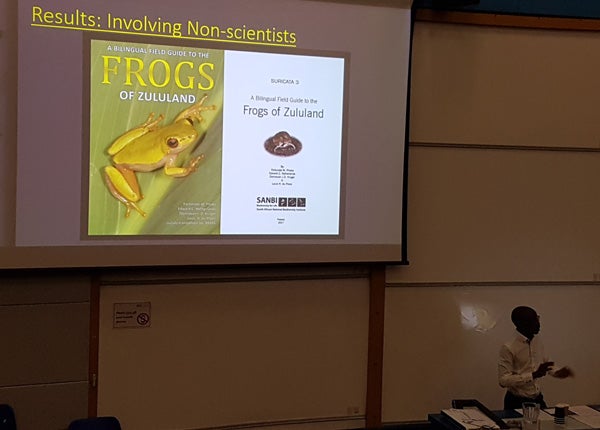
Fortunate Phaka discusses his book Frogs of Zululand. I must get a copy. Credit: Darren Naish
Fortunate Phaka discussed ecotourism and frogs in Ndumo Game Research, South Africa, a scheme of community-based ecotourism encouraging local people to develop knowledge and interest in their local amphibians. Fortunate and his colleagues have produced a book on frogs and have trained rangers and others to recognise the frog species of the region. Local people will do things to help frogs, but this works best when those people are listened to; when the discussions are on their terms. Sam Cruickshank followed up with a talk on how population size and demographic data is inferred from counts of frogs observed in the wild – some techniques are not especially reliable, the error bars resulting from some estimates giving potential population sizes very different from reality.
And in the very last talk of the meeting, Björn Encke spoke about ‘Big stories from small messangers’. The sounds made by frogs are important (however you choose to interpret that word) to people the world over; Björn discussed the work of Ben Patterson (1934-2016), a musician who – at the time of his death – was working on a music project that involved frogs.
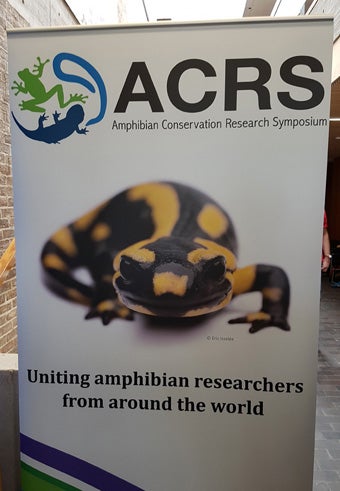
Banner at the meeting. The fire salamander photo is by Eric Isselée. Credit: Darren Naish
And, so: the end. The meeting as a whole was closed by Richard Griffiths; there were awards for speakers and expressions of gratitude to the organisers. Posters were also at the meeting but I can’t discuss all of them as well. All in all, it was an excellent, well-run meeting that featured a brilliant set of talks, much of it involving researchers at the forefront of global amphibian conservation. I will definitely be thinking about going to future events.
The ACRS was not the first amphibian-themed meeting I’ve attended: I remember in particular the special caecilian meeting I attended at the ZSL in 2009 (go here and here). Furthermore, one of the key players in global amphibian conservation in the UK – Helen Meredith – gave a talk at the very first TetZooCon back in 2014 (here’s photographic evidence). Anyway, I hope you enjoyed this report on the meeting, and I intend as always to write more about amphibians here in the near future.
For previous Tet Zoo articles on amphibians and their conservation, see...
Refs - -
Hanken, J. 1999. Why are there so many new amphibian species when amphibians are declining? Trends in Ecology & Evolution 14, 7-8.
Kanagavel, A., Parvathy, S., Nirmal, N. & Raghavan, R. 2017. Do frogs really eat cardamom? Understanding the myth of crop damage by amphibians in the Western Ghats, India.Ambio doi: 10.1007/s13280-017-0908-8
Marris, E. 2008. Bagged and boxed: it’s a frog’s life. Nature 452, 394-395.
Martel, A., Blooi, M., Adriansen, C., Van Rooij, P., Beukema, W., Fisher, M. C., Farrer, R. A., Schmidt, B. R., Tobler, U., Goka, K., Lips, K. R., Muletz, C., Zamudio, K. R., Bosch, J., Lötters, J., Wombwell, E., Garner, T. W. J., Cunningham, A. A., Spitzen-van der Sluijs, A., Salvidio, S., Ducatell, R., Nishikawa, K., Nguyen, T. T., Kolby, J. E., Van Bocxlaer, I., Bossuyt, F. & Passmans, F. 2014. Recent introduction of a chytrid fungus endangers Western Palearctic salamanders. Science 346, 630-631.
Snell, C., Tetteh, J. & Evans, I. H. 2005. Phylogeography of the Pool frog (Rana lessonae Camerano) in Europe: evidence for native status in Great Britain and for an unusual postglacial colonization route. Biological Journal of the Linnean Society 85, 41-51.